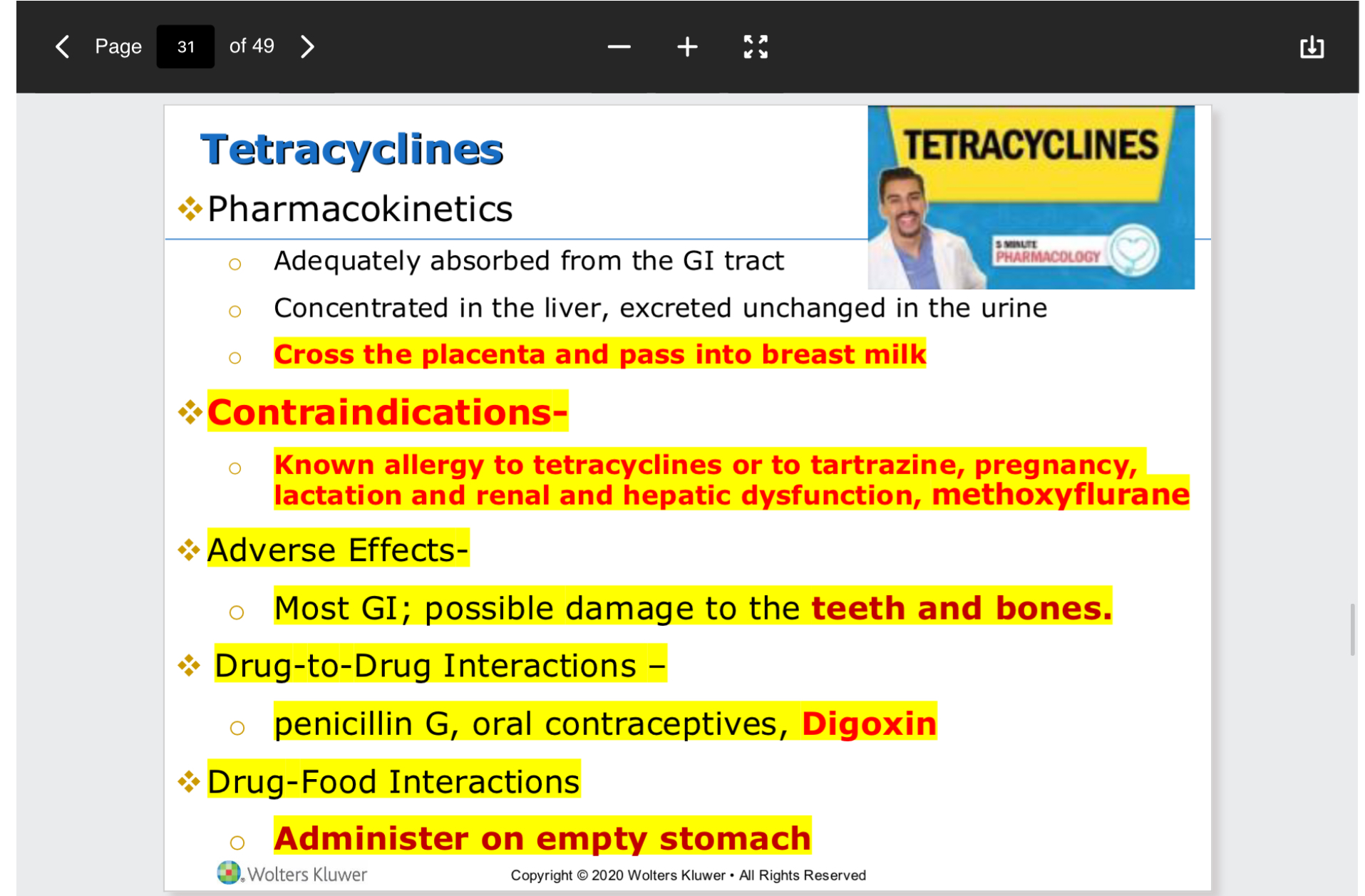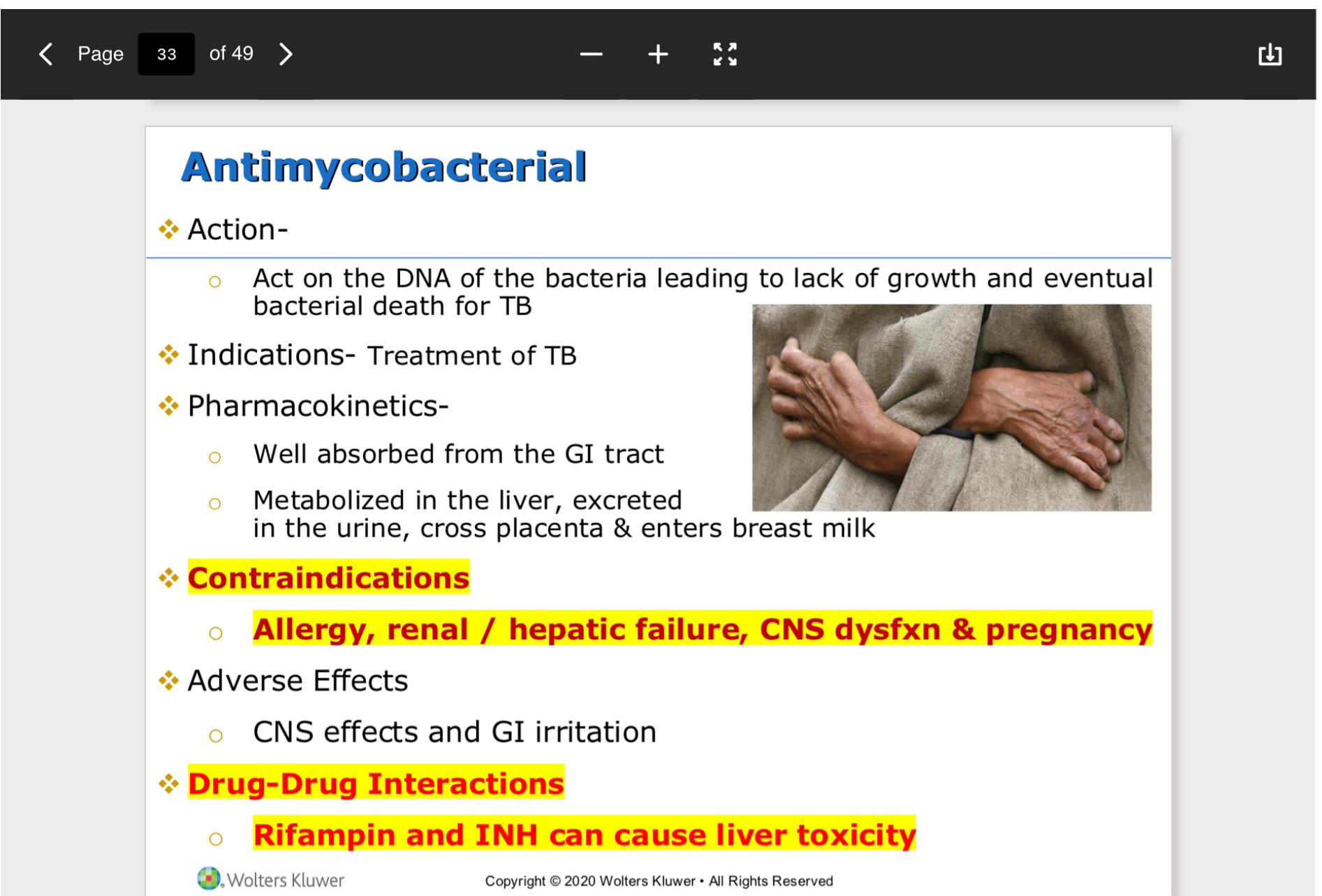Antibiotic Mechanisms and Uses
1/34
Earn XP
Description and Tags
These flashcards cover the mechanisms of action, examples, uses, and key nursing considerations for various classes of antibiotics.
Name | Mastery | Learn | Test | Matching | Spaced |
|---|
No study sessions yet.
35 Terms
Aminoglycosides
A class of antibiotics that inhibit bacterial protein synthesis by binding to the 30S ribosomal subunit.
Example Drugs (Aminoglycosides)
Gentamicin and Neomycin
pharmacokinetics (aminoglycosides)
Why did they distributed throughout the body, crossing the placenta and entering breastmilk
Common Uses (Aminoglycosides)
Severe gram-negative infections (e.g., sepsis, peritonitis).
Key Adverse Effects (Aminoglycosides)
Ototoxicity, nephrotoxicity; monitor BUN/Cr and hearing; peak/trough levels required.
Cephalosporins
A class of antibiotics that inhibit bacterial cell wall synthesis (β-lactam).
Example Drug (Cephalosporins)
Ceftriaxone.
Common Uses (Cephalosporins)
Respiratory, skin, urinary infections.
Key Adverse Effects (Cephalosporins)
Cross-sensitivity with penicillin; avoid alcohol (disulfiram reaction).
pharmacokinetics (cephalosporins)
cross the placenta and enter breastmilk
contraindications (cephalosporins)
allergies to cephalosporins or penicillin, hepatic or renal impairment
Fluoroquinolones
A class of antibiotics that inhibit DNA gyrase and topoisomerase IV.
Example Drugs (Fluoroquinolones)
Ciprofloxacin & Levofloxacin
Common Uses (Fluoroquinolones)
treating infections caused by susceptible strains of gram-negative, bacteria. (UTIs, respiratory, and skin infections)
Key Adverse Effects (Fluoroquinolones)
depression
pharmacokinetics (fluroquinolones)
absorbed in G.I. tract, metabolized in the liver, excreted in urine and feces and cross the placenta and enter breastmilk
contraindications (fluroquinolones)
known allergy, pregnancy, or lactating women and renal dysfunction
Penicillins
first anabiotic introduced for clinical use. Penicillin is only effective against gram-positive bacteria.
Example Drug (Penicillins)
Amoxicillin.
Common Uses (Penicillins)
Gram-positive infections, strep throat, ear infections.
pharmacokinetics (penicillins)
rapidly absorbed from the G.I. tract, reaching peak levels in 1 hour. Excreted unchanged in the urine and enter breastmilk.
contraindications (penicillins)
allergies to penicillin or cephalosporins, renal disease, use cautiously with patients who are pregnant or lactating
Sulfonamides
A class of antibiotics that inhibit folic acid synthesis (bacteriostatic).
well absorbed from GI tract
metabolized and liver, excreted in urine and our teratogenic
Example Drug (Sulfonamides)
cortimoxazole (Septra, Bactrim)
Common Uses (Sulfonamides)
UTIs, bronchitis, otitis media.
Tetracyclines
A class of antibiotics that bind to the 30S ribosome, blocking tRNA binding and protein synthesis.
Example Drug (Tetracyclines)
Doxycycline (Doryx, Acticlate)
Minocycline (Minocin)
Common Uses (Tetracyclines)
Acne, Lyme disease, respiratory infections.
Key Adverse Effects (Tetracyclines)
Tooth discoloration; photosensitivity; avoid dairy, antacids; not for pregnancy/children, take on empty stomach.

Macrolides
A class of antibiotics that inhibit protein synthesis by binding to the 50S ribosomal subunit.
Example Drug (Macrolides)
Azithromycin.
Antimycobacterials
A class of antibiotics that inhibit mycolic acid synthesis; affect RNA polymerase.
Example Drugs (Antimycobacterials)
Rifampin (Rifadin)
INH
Common Uses (Antimycobacterials)
Tuberculosis, leprosy.
Key Adverse Effects (Antimycobacterials)
Liver toxicity
